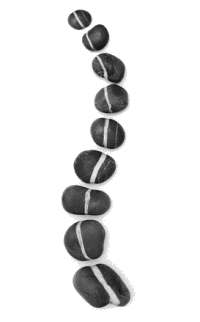Chiropractic
 Overview
Overview
Chiropractic comes from the Greek words "kheir," meaning hand, and "prakiikos," which is to use, or "done by hand." These healthcare practitioners are known to diagnose by touching, an act they call palpation. It is used to treat disorders of the joints, muscles and spine by means of manual adjustment. The use of x-rays is also part of the analysis for most chiropractors.
While chiropractic's main focus is usually on the spinal vertebrae, it can also work on joints, bones, tendons, muscles and ligaments. Chiropractors claim the manipulative process they use can have a beneficial effect on the nervous system and can help alleviate such conditions as asthma and irritable bowel syndrome, which are not musculoskeletal, as well as ones which are.
Surgery and drugs are not used by chiropractors, who adhere to alternative therapies and believe in a body's vital force, or homeostasis. Chiropractors believe that when the body's systems are in harmony, the body can heal itself from within.
History of Chiropractic
An American self-taught student of anatomy named Daniel David Palmer developed chiropractic therapy in the late 1800s. He thought the body had a natural ability to maintain good health and that the key to this state was grounded in normal nerve function. Palmer theorized that misaligned vertebrae, known as subluxations, can interfere with proper nerve function and thus lead to undesired health conditions. Palmer also thought he was capable of treating disorders throughout the body by simply using his hands to return the vertebrae to their proper positions.
For many years traditional medical physicians were opposed to chiropractic and sought to limit its practice. They thought it had no place in the medical world because it offered no benefits to patients. Today, chiropractic is recognized for its benefits and its practitioners are licensed around the globe.
How Chiropractic is Practiced
Chiropractors attend accredited colleges and take courses in anatomy, microbiology, physiology, nutrition and other health-related subjects. Not unlike medical doctors, a chiropractor's education also includes hands-on experience in treating patients. In some regions, chiropractors are also licensed to practice various conventional medical techniques such as minor surgery and setting fractures of bones.
Diagnostic tools such as x-rays are frequently utilized to confirm what the physical exam has told the chiropractor and to check for other causes such as tumors or osteoporosis.
The Chiropractic Phases
There are more than 100 techniques that can be used for chiropractic manipulation. Some involve applying sudden force to an area of the spine in order to correct a subluxation or to a joint to increase its range of motion. These techniques usually are done on a Cox table, which is an examination table with an opening for the face. The patient lies face down, but is generally placed on his or her side for manipulation of the lower back. The mid and upper back are manipulated with the patient lying face down, while neck and cervical manipulation is conducted with the individual sitting or lying on their back.
Treatments with a chiropractor typically are conducted in three phases. The first phase involves acute care, aiming to correct the misalignments of the spine and to reduce pain. The second phase is restorative, where the chiropractor schedules one or more follow-up exams to ensure the spine stays aligned. The third is a wellness phase and consists of check-ups which are used to identify new subluxations.
Chiropractors also give dietary advice, offering help with choices for sensible eating and weight control. Injections of nutritional supplements or prescriptions for such aids may also be given. Some chiropractors make use of herbal medicines, acupuncture and homeopathy.
Conditions Benefited by Chiropractic Manipulation
People suffering from the following conditions may find some relief by making use of the services of a chiropractor:
- Headaches - Manipulation by a chiropractor may help to prevent tension headaches.
- Low back pain - Most individuals visit a chiropractor because of back pain. Chiropractic manipulation has been found to be as effective for treating back pain as conventional medical practices.
- Asthma - Chiropractic spinal manipulation has been found to be a beneficial adjunct to conventional medicine in treating children with asthma.
- Fibromyalgia - The use of chiropractic manipulation often reduces pain and fatigue in such patients and may improve sleep as well.
- Colic - Some research regarding babies with colic have shown that chiropractic manipulation helps them to stop crying, which indicates a reduction in their discomfort from colic.
- Phobias - Those suffering from phobias who seek chiropractic manipulation have been known to significantly reduce emotional triggers from the object of their phobias.
Adverse Reactions
A few recent case reports have been made which may link chiropractic manipulation to serious complications. These cases involve manipulation of the cervical spine and neck and may increase the risk of spinal fractures, nerve damage or stroke. A reduction for such risks can be achieved by discussing any underlying problems with the chiropractor before treatments begin.
References
- Bratman, S. The Alternative Medicine Ratings Guide: an expert panel rates the best treatments for over 80 conditions, Prima Health A Division of Prima Publishing (1998)
- Brown, L. Alternative Medicine, NTC/Contemporary Publishing (1999)
- Deepak Chopra, M.D. Alternative Medicine: The Definitive Guide, Celestial Arts (2002)
- Nancy Allison. The Illustrated Encyclopedia of Body-Mind Disciplines, The Rosen Publishing Group (1999)
- Servan-Schreiber, D. The Encyclopedia of New Medicine: Conventional & Alternative Medicine For All Ages, Rodale International Limited (2006)
Posted in Chiropractic
Ask a Question Or Join a Discussion


